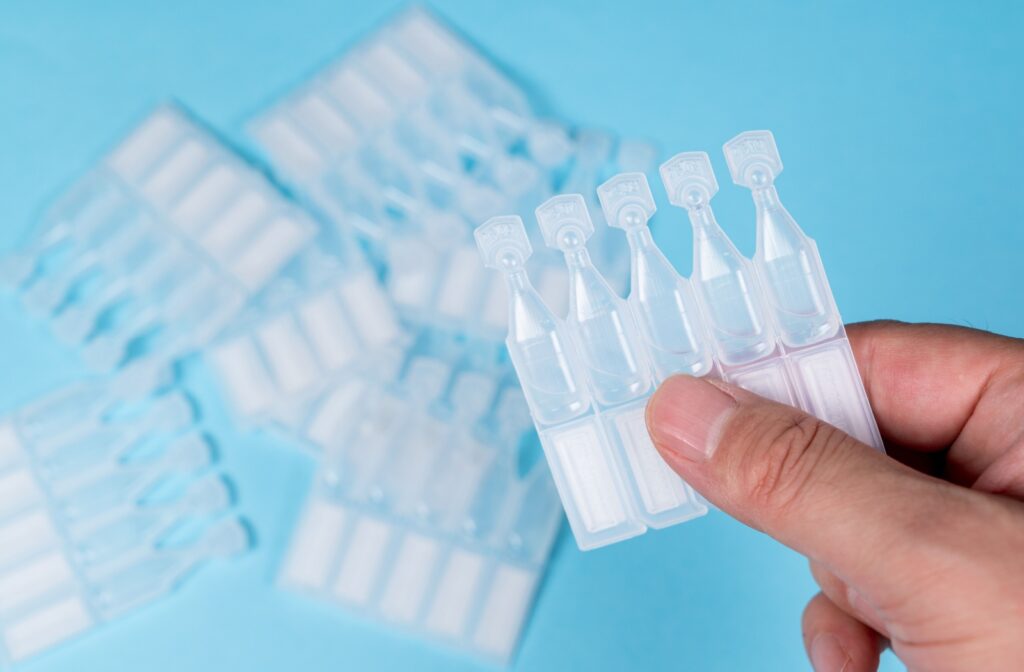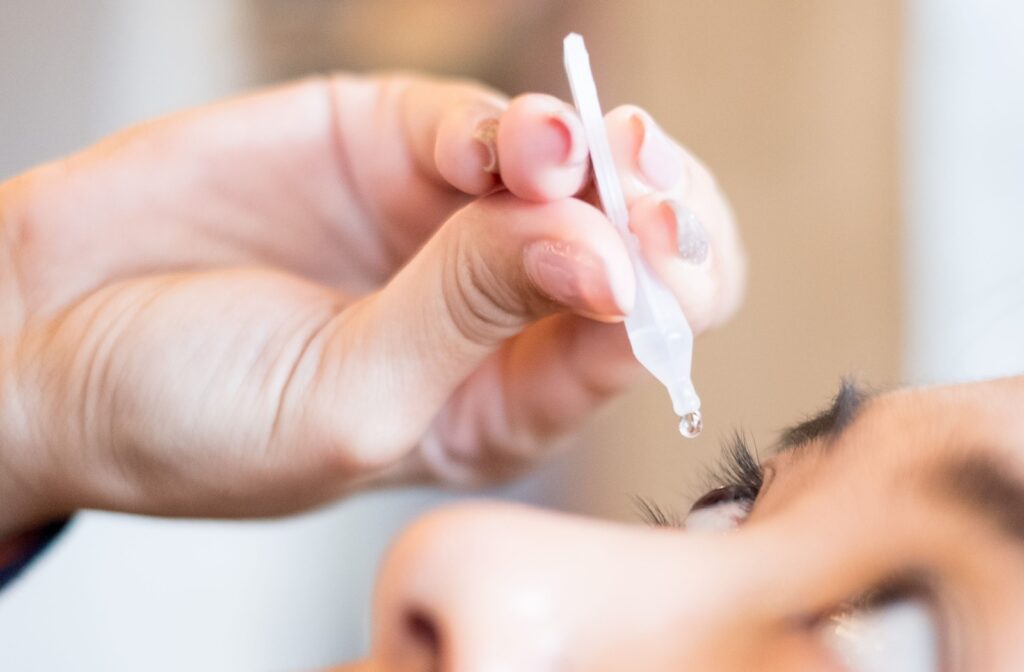When you’re experiencing symptoms of dry eye, artificial tears can seem like an easy and accessible solution. But there are important things to know about these products, which are often available over the counter without a prescription. For example, artificial tears with preservatives should not be used more than 4 times a day.
If you have symptoms of dry eye, consider booking an eye exam with your optometrist. Dry eye is a common condition with many treatment options. An optometrist can assess your eyes and discuss treatment options with you.
What Are Artificial Tears?
Artificial tears are products used to lubricate the eye. They may come in the form of eye drops, ointments, or gels, and don’t typically require a prescription. You can buy artificial tears at your local pharmacy.
Our tears consist of mucus, water, and oil. Artificial tears work by adding to either the oil or water layer of our natural tears. No matter the type of product you choose, be sure to read the package insert and pay attention to expiry dates.
Types of Artificial Tears
There are two main categories of artificial tears: preservative and preservative-free. Products with preservatives typically come in a multi-use bottle, and the preservatives help inhibit bacterial growth after the bottle has been opened. However, chemicals used as preservatives may irritate some people’s eyes, especially the eyes of people with moderate to severe dry eye.
Preservative-free artificial tears may come in single-dose packages. They can be an appropriate choice for people who need to use artificial tears more frequently.
Can You Use Artificial Tears Too Often?
Yes, it’s possible to use artificial tears too often. Practice caution when it comes to products with preservative additives. You shouldn’t use artificial tears with preservatives more than 4 times a day.
Artificial tears without preservatives are often recommended for people who need more than 4 doses a day. But you should still discuss a dosing plan with your optometrist. That’s because, in addition to safety, if you’re using artificial tears very often, there may be an underlying condition that warrants further investigation.
Effects of Overuse
Symptoms of artificial tear overuse may include redness, excessive tears, discomfort and irritation, and blurry vision. If you notice these symptoms, see your optometrist, especially if they’re new or getting worse.
Be aware that eye drops advertised to treat red eyes are actually decongestants. These products can make dry eye symptoms worse. They may also cause rebound redness and may not be safe to use if you have certain eye conditions like glaucoma.

What Is Dry Eye?
To understand artificial tears, it may help to better understand the condition you are likely using the artificial tears to treat: dry eye.
Dry eye is a common problem experienced by many, especially older adults. It happens when you don’t produce enough tears, your tears drain too quickly, or if the tears you produce are of an inadequate quality.
Our tears are a delicate balance of water, mucus, and oil. Dry eye symptoms can occur if there is an issue with the chemical composition of our tears.
Symptoms of dry eye include:
- The feeling that there is something in your eye
- Grittiness, scratchiness, or a burning sensation
- Redness
- Excessive tears
- Mucus
- Blurry vision
- Sensitivity to light
Sometimes, dry eye is a symptom of an underlying health condition like rheumatoid arthritis or diabetes.
Treatments for Dry Eye Beyond Artificial Tears
Artificial tears are often a first-line treatment for dry eyes, and for many people, they can be helpful. But you have other options. These can include:
- Changing your environment: Dry air and dusty environments can worsen symptoms of dry eye. Consider placing a humidifier in your room if the air is too dry. Avoid environmental irritants like smoke and air conditioning. Wraparound sunglasses can help protect your eyes against these triggers.
- Lifestyle changes: Try to get enough sleep and remember to stay hydrated. If you use screens a lot, remember to take breaks. The 20-20-20 rule—where you look at an object 20 feet away for 20 seconds every 20 minutes—can be helpful if you’re a heavy screen user.
- Prescription medications: Drugs like cyclosporine or lifitegrast can treat serious cases of dry eye by helping you produce more tears.
- Punctal plugs: These are plugs placed into the tear ducts to prevent tears from draining too quickly.
Get Support for Dry Eye
On the surface, dry eye may seem like a minor problem. But it can significantly impact a person’s quality of life, affecting productivity, recreational activities, and social time. And if it’s left untreated, dry eye can even harm your cornea.
An optometrist can help. If you’re experiencing dry eye, book an appointment at Total Vision Tierrasanta. We can discuss which treatment options may suit your personal needs.


